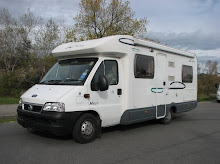
Parque Nacional Monfragüe
A short hop on the N630 (Ruta de la Plata – thank you Romans) to Placencia where we take a look at the Roman viaduct and watch some lads playing Saturday morning football - they all want to be Ronaldo.
Just a few minutes from Placencia we climb and are in the sierra that is the Parque Nacional Monfragüe, Spain’s newest park created in 2006 and covering 18,000 hectares. The park straddles the Tajo valley and is home to 75% of Spain’s protected species.
Being the weekend it is busier than we are used to but still we can find plenty of space to walk and watch for birds. A visit to the information centre, we prepate a packed lunch and are off to the hilltop vantage point of Cerro Gimio. Along a stone path to start and then we follow a narrow and rocky footpath beside a stream before climbing to the rocky heights we are aiming for. Huge areas have been replanted and although the saplings are yet to outgrow their protective covers in 15 or 20 years this will be a forest. Meanwhile we are walking among cistus, heather and rosemary and the Spring flowers are blooming.
After an hour and a half we reach the top and are greeted by a fantastic view across the Tajo, the cliffs of Salto del Gitano and the castle of Monfragüe. As we lunch we are able to watch Griffon Vultures as they soar from below us and climb on the thermals. There is much excitement as we spot red deer in the woods far below.
After our return we take the scenic drive along the river valley and stop opposite a sheer cliff face which is home to a colony of Griffon Vultures and are lucky enough to see these sitting on nests and also spot a pair of Egyptian Vultures, a Short-toed Eagle as well as a flock of Azure-winged Magpies. Tick. Tick, tick!!
We camp over night just outside the park and thanks to the free wi-fi can catch up on England’s draw in the Culcutta Cup – deep despair follows which only a bottle of Los Molinos can cure.
The following morning we decide to take a route through the park on our way to Trujillo. We stop at various viewpoints and are rewarded good sightings of more raptors and our first Black Stork. Tick!
As we emerge from the hills we enter the plains once again, cattle, pigs and sheep are being raised here. The land is wooded by cork oaks with their lower trunks stripped bare. Cereals and, controversially, tobacco which heavily subsidised by the EU are being grown here. The game now becomes one of spotting the electricity pylon with the most White Stork nests precariously balanced in their structures. Two is common, three or four seen regularly but the all time record goes to a pylon East of Trujillo where 9 nests were counted by the co-pilot – that’s almost a stork high-rise!






No comments:
Post a Comment